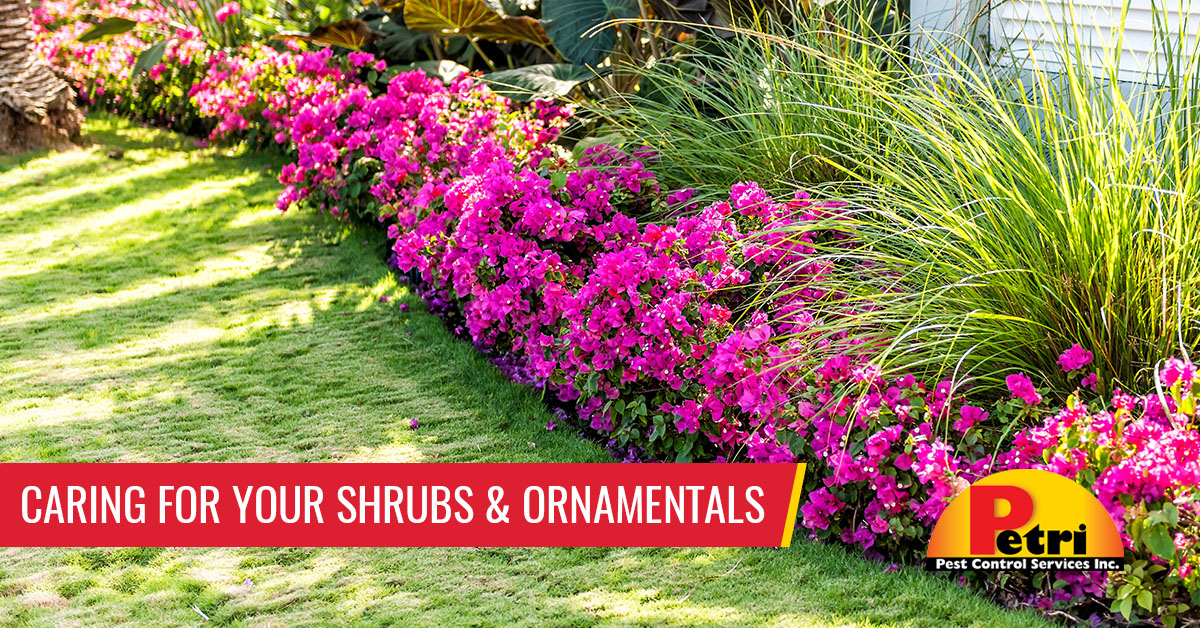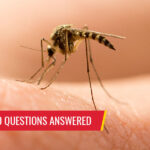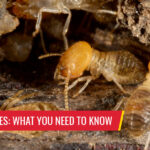
It’s summer, usually that carefree season of vacations, staycations, and all manner of fun in the South Florida sun. However, this year with more “staycations” than vacations combined with Florida heat and pests you have more time to notice the damage and stress the heat produces for your shrubs and ornamental plants. Beautiful shrubs and ornamental plants accent your property with vibrant colors and attract butterflies and hummingbirds but they need a little extra TLC in the summer. We have gathered suggestions that South Florida homeowners can take to care for their plants as well as some things Petri Pest Control Services can do help you care for your plants and shrubs this summer.
Pests are drawn to the favorable conditions that support shrubs and ornamentals
Due to the favorable growing conditions for tropical ornamental plants and shrubs in the Sunshine State, a variety of plants are suitable for these warm, humid conditions. Selecting the right plants and shrubs makes a difference when trying to keep pests away for several reasons, including:
- Making sure your choice of plants is suitable for the light and water conditions on your property – essential to growing a healthy landscape.
- Making sure your plants are non-invasive. Invasive plants may look pretty when planted but tend to overwhelm your landscape and take over, crowding out your other plants.
It’s no surprise that your selection of flowering and woody beauties are fair game to several Florida pests that are gearing up in summer to devour them. Along with fending off pests and diseases, such as fungi and mildew, the weather, fertilization, and watering also play a role in keeping your shrubs and ornamentals happy and healthy this summer.
Proper watering and irrigation
Watering too much can cause root rot with shrub and ornamental leaves turning yellow and eventually falling off your plants. Watering too little can cause wilting and weaken plants that are less hardy than others. Weather conditions can also play a role in increased insect activity. Dry spells, often accompanied by strict watering schedules and restrictions can cause mites to feed on plants as a water source. On the opposite end of the spectrum, a lot of rain, not something you can control, but be sure you are not watering your plants in addition to large amounts of rain they may have received.
Adequate fertilization is important
Keeping your landscape plants watered properly and well-fed is one of the best things you can do to fend off environmental stresses, fungi, diseases, and pests. Stressed plants send out plant pheromones that attract insects to weakened plants along with the healthier shrubs and ornamentals nearby. Insects that can cause significant damage to Florida shrubs and ornamentals include the following:
- Grasshoppers and caterpillars with chewing mouthparts – Caterpillars or the larval stage of moths and grasshoppers cause visible damage, showing up as ragged leaf edges, holes in leaves, and other missing tissue. Eastern lubber grasshoppers can attack in large numbers and actually defoliate landscape plants.
- Aphids, scales, spider mites, and notorious whiteflies use their piercing-sucking mouthparts – these insects cause lateral damage to leaves, these pests move across leaves causing yellowing or browning of leaves and possible wilting with their strong mandibles. Aphids can affect every part of the plants they attack. Many common plants such as Ixoras, Hibiscus, Camellia, Crepe Myrtle, Gardenia, Oleander, Photinia, Roses, and Viburnum are very susceptible to piercing-sucking insects.
Other plant damaging insects are classified by the damage they do, such as:
- Leaf miners burrow into the leaves of plants leaving tell-tale tunnels in the leaves, such as well-known citrus leaf miners, which are actually the larval stage of a moth.
- Gall makers crawl into plant tissue – typically leaves, stems, or twigs, causing leaf tissues to swell. Blueberry gall midge larvae burrow into leaves to feed and gall wasps deposit their eggs into plant tissues.
- Wood/phloem borers cause damage, feeding on living wood, such as twig girdlers and powderpost beetles.
Just as different insects cause damage to different plants, treating for pests can be challenging, as well. Some insects are resistant to insecticides while some treatments for insects may make the situation worse by also eliminating beneficial insects that prey on those pests.
Sound like a lot to keep up with? Not sure what’s too much water or just enough fertilizer or whatever those crawling or flying things are that are eating your plants? Petri Pest Control Services can help.
Petri Pest Control Services Offers a Shrub and Ornamental Program
We offer convenient shrub and ornamental care programs as a stand-alone option or as part of our larger lawn care treatment program. Petri Pest Control Services’ lawn care professionals are experts at helping keep your shrubs and ornamental plants healthy and pest-free year-round.
How does Petri Pest Control Services’ Professional Shrub and Ornamental plant care work?
First, we recommend that lawn customers protect and maintain their shrubs and ornamentals as a comprehensive solution for their properties, along with lawn care. For your shrub and ornamental plant care, Petri Pest Control Services recommends:
- Spraying shrubs and ornamentals on a regular schedule throughout the year for the best outcome.
- Treating commonly occurring fungi often caused by overwatering with a fungicide if a fungus condition exists.
- Treating larger trees that are susceptible to disease and pests as an additional service or on a case by case basis. In some cases, Petri Pest Control Services may refer you to an arborist or a tree company.
If you need lawn care assistance in South Florida, you can count on the professionals at Petri Pest Control Services. Serving South Florida since 1956 from our location in Pompano Beach, we provide Broward and Palm Beach counties with trusted and reliable local pest control and lawn care services!
Don’t Shrub It Off: How To Care For Your Florida Shrubs & Ornamental Plants This Summer in South Florida
Serving Broward County and Palm Beach County


